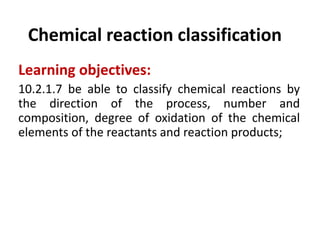
17 ppt v1_10_chemistry_classification of chemical reactions
- 1. Chemical reaction classification Learning objectives: 10.2.1.7 be able to classify chemical reactions by the direction of the process, number and composition, degree of oxidation of the chemical elements of the reactants and reaction products;
- 2. Physical and chemical changes How many physical and chemical changes can you spot?
- 3. What is a chemical reaction? cooking rusting sticking burning making metals living! Can you think of any other chemical reactions? Chemical reactions do not only happen in the laboratory. Chemical reactions happen anywhere that new substances are made:
- 4. Group work Get into 4 groups Classify chemical reactions - depending upon the direction of the reaction; - depending upon the evolution or absorption of heat; - depending upon the degree of oxidation of the chemical elements; - depending upon the number and composition of the reactants and reaction products Be ready to present
- 5. Practical -activity PART A - SYNTHESIS Get a piece of copper wire from your teacher. Note the appearance of the wire. Using crucible tongs, hold the wire in the hottest part of a burner flame for 1 to 2 minutes. Examine the wire and note any change in its appearance caused by heating. Place an evaporating dish near the base of the burner. Get a piece of magnesium from your teacher. Examine a piece of magnesium ribbon. Using crucible tongs, hold the sample in the burner flame until the magnesium starts to burn. DO NOT LOOK DIRECTLY AT THE FLAME. HOLD THE BURNING MAGNESIUM AWAY FROM YOU AND DIRECTLY OVER THE EVAPORATING DISH. When the ribbon stops burning, put the remains in the evaporating dish. Examine this product carefully.
- 6. PART B - DECOMPOSITION Place 2 heaping microspatulas of copper (II) carbonate (CuCO3) in a clean, dry test tube. Note the appearance of the sample. Using a test tube holder, heat the CuCO3 strongly for about 3 minutes. Insert a burning wood splint into the test tube. If carbon dioxide gas (CO2) is present, it will put the flame out. Note any change in the appearance of the residue in the test tube. PART C- DOUBLE REPLACEMENT Add about 2 mL of 0.1 M Lead Nitrate Pb(NO3)2 to a clean, dry test tube. Next, add about 2 mL of 0.1 M Potassium Iodide (KI) to the test tube. Observe what happens and note any changes in the mixture.
- 7. PART D - SINGLE REPLACEMENT 6. Stand a clean, dry test tube in the test tube rack. Add about 5 mL of 3 M hydrochloric acid (HCl) to the tube. CAUTION. Handle acids with care. They can cause painful burns. Do not inhale any HCl fumes. Now carefully drop a small piece of zinc metal (Zn) into the acid in the test tube. Observe and record what happens. 7. Using a test tube holder, invert a second test tube over the mouth of the test tube in which the reaction is taking place. See the diagram to the right. Remove the inverted tube after 30 seconds and quickly insert a burning wood splint into the mouth of the tube. (A “pop” indicates the presence of hydrogen gas.) Note the appearance of the substance in the reaction test tube. 8. Add about 5 mL of 1 M copper (II) sulfate (CuSO4) solution to a clean, dry test tube. Place a small amount of zinc metal in the solution. Note the appearance of the solution and the zinc before and after the reaction.